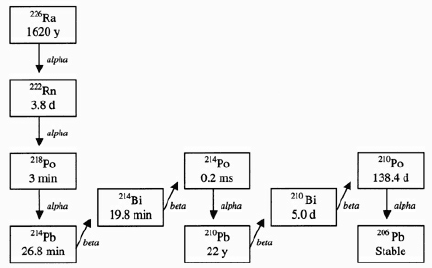
Radon Measurement with a Lucas cell
A Lucas cell is used to grab a gas sample, filter out the radon daughters through a special filter at 0.01 microns, and counts the radioactive decay of radon gas. The inside of the 1-liter gas chamber is coated with silver activated zinc sulphate or ZnS(Ag) that scintillates or shines when struck by alpha particles. After a great deal of consultation, I used 3M super 33 spray adhesive was used to hold the Zns(Ag) to the inside of the gas chamber. A cone shaped 5 inch photomultiplier tube at the top of the chamber counts the photons and sends the count to the Eberline ESP-1.
For this example, we will use The Uranium Series that begins with uranium 238, Since it's radon has the longest half-life, it poses the most danger to humans. The decay chain is as follows. 238U->234Th->234Pa->234U->230Th->226Ra->222Rn Natural radium-226 decays into radon-222 and becomes a gas from a solid Radon 222 with a half-life of 3.82 days and is transported up throught the soil and decays into radon daughters, a solid again. Radon daughters from 222Rn then continue as follows. 218Po->214Pb->218At->214Bi-> 214Po->210Tl->210Pb->210Bi->210Po->206Tl and then finally it turns into206Pb stable isotopic lead.
Radon itself is an inert gas, much like Helium, Argon, Xenon, and Krypton gas. Its' danger lies in the fact that its' daughters accumulate in the dust in your house. The Radon Daughters are radioactive solids that lodge in your lungs and bombard them with alpha and beta radiation.
NEW: Radon extracted from oil well gas 17500 CPM = 17500 pCi/l to hear the wave file.
Radon from a Water Well here is the decay graph.
Wave file after 120 Minuits of decay.
If you need a sample of radon daughters wipe your computer monitor or TV the black stuff is radioactive. In addition, those plastic grocery bags, if left in a high radon environment collect radon daughters due to static charge. The EPA recomends a radon level of no more than 4 pCi/l in the air. The average in my home is 2.4-3 pCi/l. On a rainy, low barometer day I have measured up to 7 pCi/l. The Eberline provides 660 vdc to operate the photomultiplier tube and returns real time data in CPM counts per minute. Alternatively, picocuries per liter (pCi/l). Itís the fastest way to measure radon gas, easily! Radon seeps up fast in high precipitation events and low barometers. The Lucas cell is complete, calibrated and field ready after 2 years. My next goal is to post daily online grab samples to demonstrate how weather effects radon outflow from the soil.
Thanks Pat!